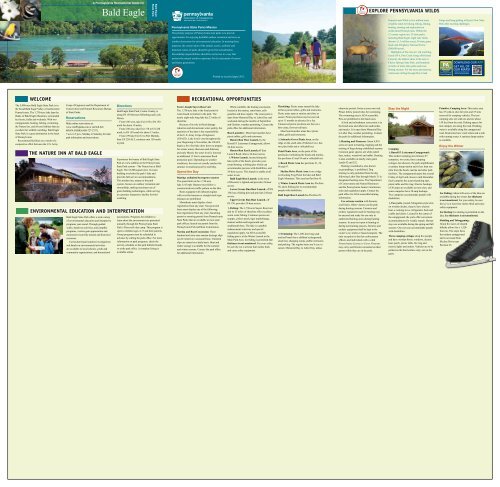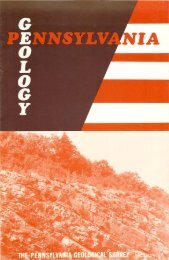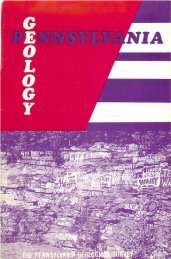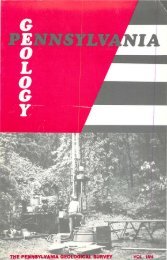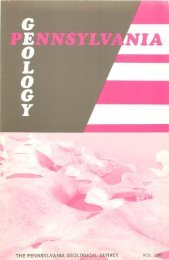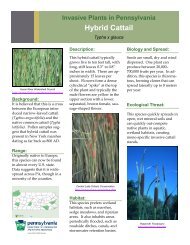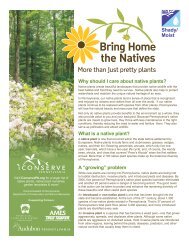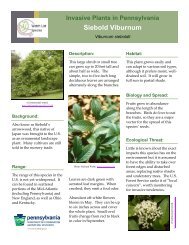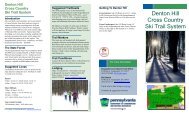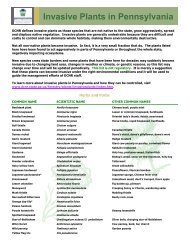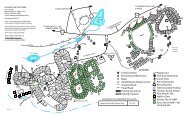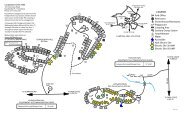Bald Eagle - Pennsylvania Department of Conservation and Natural ...
Bald Eagle - Pennsylvania Department of Conservation and Natural ...
Bald Eagle - Pennsylvania Department of Conservation and Natural ...
Create successful ePaper yourself
Turn your PDF publications into a flip-book with our unique Google optimized e-Paper software.
A <strong>Pennsylvania</strong> Recreational Guide for <strong>Bald</strong><br />
<strong>Bald</strong> <strong>Eagle</strong><br />
<strong>Eagle</strong><br />
WELCOME RECREATIONAL OPPORTUNITIES<br />
The 5,900-acre <strong>Bald</strong> <strong>Eagle</strong> State Park is in<br />
the broad <strong>Bald</strong> <strong>Eagle</strong> Valley <strong>of</strong> northcentral<br />
<strong>Pennsylvania</strong>. The 1,730-acre lake laps the<br />
flanks <strong>of</strong> <strong>Bald</strong> <strong>Eagle</strong> Mountain, surrounded<br />
by forests, fields <strong>and</strong> wetl<strong>and</strong>s. With two<br />
campgrounds, boating, fishing, swimming,<br />
the Nature Inn, <strong>and</strong> diverse habitats that are<br />
excellent for wildlife watching, <strong>Bald</strong> <strong>Eagle</strong><br />
State Park is a great destination in the heart<br />
<strong>of</strong> <strong>Pennsylvania</strong>.<br />
Recreational facilities are a result <strong>of</strong> a<br />
cooperative effort between the U.S. Army<br />
Corps <strong>of</strong> Engineers <strong>and</strong> the <strong>Department</strong> <strong>of</strong><br />
<strong>Conservation</strong> <strong>and</strong> <strong>Natural</strong> Resources-Bureau<br />
<strong>of</strong> State Parks.<br />
Reservations<br />
Make online reservations at:<br />
www.visitPAparks.com or call toll-free<br />
888-PA-PARKS (888-727-2757),<br />
7 a.m. to 5 p.m., Monday to Saturday, for state<br />
park information <strong>and</strong> reservations.<br />
THE NATURE INN AT BALD EAGLE<br />
Directions<br />
State Park<br />
<strong>Bald</strong> <strong>Eagle</strong> State Park, Centre County, is<br />
along PA 150 between Milesburg <strong>and</strong> Lock<br />
Haven.<br />
From I-80 west, take Exit 158 to PA 150<br />
north for about 10 miles.<br />
From I-80 east, take Exit 178 to US 220<br />
north, to PA 150 south for about 13 miles.<br />
From I-99 take Exit 61 to Port Matilda,<br />
then US 220-ALT, continue onto 150 north<br />
to park.<br />
Experience the beauty <strong>of</strong> <strong>Bald</strong> <strong>Eagle</strong> State<br />
Park at a new addition to the <strong>Pennsylvania</strong><br />
State Park system—The Nature Inn at <strong>Bald</strong><br />
<strong>Eagle</strong>. The 18,500-square-foot, 16-room<br />
building overlooks the park’s lake <strong>and</strong><br />
provides full-service accommodations.<br />
This modern inn, unique to the park<br />
system, focuses on outdoor recreation <strong>and</strong><br />
stewardship, making maximum use <strong>of</strong><br />
green building technologies, while serving<br />
as a premier interpretive facility for bird<br />
watching.<br />
ENVIRONMENTAL EDUCATION AND INTERPRETATION<br />
<strong>Bald</strong> <strong>Eagle</strong> State Park <strong>of</strong>fers a wide variety<br />
<strong>of</strong> environmental education <strong>and</strong> interpretive<br />
programs year-round. Through guided<br />
walks, h<strong>and</strong>s-on activities, <strong>and</strong> campfire<br />
programs, visitors gain appreciation <strong>and</strong><br />
awareness toward the natural <strong>and</strong> historical<br />
resources.<br />
Curriculum-based outdoor investigations<br />
<strong>and</strong> h<strong>and</strong>s-on environmental activities<br />
are available to local schools, youth <strong>and</strong><br />
community organizations, <strong>and</strong> homeschool<br />
associations. Programs for children to<br />
learn about the environment are presented<br />
annually through the <strong>Pennsylvania</strong> State<br />
Park’s DiscoverE day camp. This program is<br />
open to children ages 4-17 <strong>and</strong> their parents.<br />
Group programs must be scheduled in<br />
advance by calling the park <strong>of</strong>fice. For more<br />
information on park programs, check the<br />
activity schedule on the park bulletin boards<br />
or at the park <strong>of</strong>fice. A complete listing is<br />
available online.<br />
<strong>Pennsylvania</strong> State Parks Mission<br />
The primary purpose <strong>of</strong> <strong>Pennsylvania</strong> state parks is to provide<br />
opportunities for enjoying healthful outdoor recreation <strong>and</strong> serve as<br />
outdoor classrooms for environmental education. In meeting these<br />
purposes, the conservation <strong>of</strong> the natural, scenic, aesthetic <strong>and</strong><br />
historical values <strong>of</strong> parks should be given first consideration.<br />
Stewardship responsibilities should be carried out in a way that<br />
protects the natural outdoor experience for the enjoyment <strong>of</strong> current<br />
<strong>and</strong> future generations.<br />
pennsylvania<br />
WILDS<br />
Foster Joseph Sayers Reservoir<br />
The 1,730-acre lake is the focal point for<br />
water-based recreation in the park. The<br />
nearly eight-mile long lake has 23 miles <strong>of</strong><br />
shoreline.<br />
Because <strong>of</strong> its role in flood damage<br />
reduction <strong>and</strong> downstream water quality, the<br />
operation <strong>of</strong> the dam is the responsibility<br />
<strong>of</strong> the U.S. Army Corps <strong>of</strong> Engineers<br />
(USACE). Lake levels vary throughout the<br />
year. Beginning in November, the USACE<br />
begins a five-foot lake draw down to prepare<br />
for winter waters. Between mid-February<br />
<strong>and</strong> early March, the water level is lowered<br />
an additional 15 feet to maximum flood<br />
protection pool. Depending on weather<br />
conditions, the reservoir usually reaches the<br />
summer recreational pool by mid-May.<br />
Spend the Day<br />
Boating: unlimited horsepower motors<br />
The speed limit on the 1,730-acre<br />
lake is 45 mph. Boaters must follow a<br />
counterclockwise traffic pattern on the lake.<br />
Boats equipped with inboard engines<br />
with over-the-transom or straight-stack type<br />
exhausts are prohibited.<br />
Motorboats must display a boat<br />
registration from any state. Non-powered<br />
boats must display one <strong>of</strong> the following:<br />
boat registration from any state; launching<br />
permit or mooring permit from <strong>Pennsylvania</strong><br />
State Parks that are available at most state<br />
park <strong>of</strong>fices; launch use permit from the<br />
<strong>Pennsylvania</strong> Fish <strong>and</strong> Boat Commission.<br />
Marina <strong>and</strong> Boat Concession: Three<br />
hundred <strong>and</strong> sixty-nine marina dockage slips<br />
can be rented on a seasonal basis. Transient<br />
slips are rented on a daily basis. Boat <strong>and</strong><br />
trailer storage is available for the summer<br />
<strong>and</strong> winter seasons. Contact the park <strong>of</strong>fice<br />
for additional information.<br />
Printed on recycled paper 2012<br />
When available, the boating concession,<br />
located at the marina, rents boats, sells<br />
gasoline <strong>and</strong> does repairs. The concession is<br />
open from Memorial Day to Labor Day <strong>and</strong><br />
weekends during the months <strong>of</strong> September<br />
<strong>and</strong> October, weather permitting. Contact the<br />
park <strong>of</strong>fice for additional information.<br />
Boat Launches: Most boat launches have<br />
picnic tables, grills <strong>and</strong> restrooms.<br />
Hunter Run West Launch, by the<br />
Russell P. Letterman Campground, allows<br />
24-hour access.<br />
Hunter Run East Launch,<strong>of</strong>f East<br />
Launch Road, allows 24-hour access.<br />
Winter Launch, located along the<br />
lake north <strong>of</strong> the beach, provides yearround<br />
boating, a fishing pier which can<br />
accommodate persons with disabilities, <strong>and</strong><br />
24-hour access. This launch is usable at all<br />
water levels.<br />
<strong>Bald</strong> <strong>Eagle</strong> Boat Launch, in the town<br />
<strong>of</strong> Howard, is lighted <strong>and</strong> provides 24-hour<br />
access.<br />
Lower Greens Run Boat Launch, <strong>of</strong>f PA<br />
150, has a fishing pier <strong>and</strong> provides 24-hour<br />
access.<br />
Upper Greens Run Boat Launch, <strong>of</strong>f<br />
PA 150, provides 24-hour access.<br />
Fishing: The 1,730-acre Sayers Reservoir<br />
<strong>and</strong> its 23 miles <strong>of</strong> shoreline <strong>of</strong>fer excellent<br />
warm water fishing. Common species are<br />
crappie, yellow perch, tiger muskellunge,<br />
channel catfish <strong>and</strong> largemouth <strong>and</strong><br />
smallmouth bass. The lake is a panfish<br />
enhancement waterway <strong>and</strong> special<br />
regulations apply. An ADA accessible<br />
fishing pier is at the Winter Launch in the<br />
Main Park Area. Ice fishing is permitted. Ice<br />
thickness is not monitored. For your safety,<br />
be sure the ice is at least four inches thick<br />
<strong>and</strong> carry safety equipment.<br />
Picnicking: Picnic areas around the lake<br />
all have picnic tables, grills <strong>and</strong> restrooms.<br />
Picnic areas open at sunrise <strong>and</strong> close at<br />
sunset. Picnic pavilions may be reserved<br />
up to 11 months in advance for a fee.<br />
Unreserved picnic pavilions are free on a<br />
first-come, first-served basis.<br />
Most boat launches areas have picnic<br />
tables, grills <strong>and</strong> restrooms.<br />
Schencks Grove Picnic Area, on the<br />
ridge on the south side <strong>of</strong> Marina Cove, has<br />
two play fields <strong>and</strong> a volleyball net.<br />
Point Picnic Area, on the point <strong>of</strong> the<br />
peninsula overlooking the beach <strong>and</strong> marina,<br />
has pavilions #3 <strong>and</strong> #4 <strong>and</strong> a volleyball net.<br />
Beach Picnic Area has pavilions #1, #2,<br />
#6 <strong>and</strong> #7.<br />
Skyline Drive Picnic Area is on a ridge<br />
overlooking Frog Pond, the lake <strong>and</strong> <strong>Bald</strong><br />
<strong>Eagle</strong> Mountain. This area has Pavilion #5.<br />
Winter Launch Picnic Area has Pavilion<br />
#8, <strong>and</strong> a fishing pier to accommodate<br />
people with disabilities.<br />
<strong>Bald</strong> <strong>Eagle</strong> Boat Launch has Pavilion #9.<br />
Swimming: The 1,200-foot long s<strong>and</strong><br />
<strong>and</strong> turf beach has a children’s playground,<br />
snack bar, changing rooms, public restrooms<br />
<strong>and</strong> parking. The regular hours are 8 a.m. to<br />
sunset, Memorial Day to Labor Day, unless<br />
pennsylvania<br />
WILDS<br />
otherwise posted. Swim at your own risk.<br />
Please follow posted rules for swimming.<br />
The swimming area is ADA accessible.<br />
Pets are prohibited in the beach area.<br />
A food <strong>and</strong> refreshment concession is in<br />
the beach area <strong>and</strong> <strong>of</strong>fers hot s<strong>and</strong>wiches<br />
<strong>and</strong> snacks. It is open from Memorial Day<br />
to Labor Day, weather permitting. Contact<br />
the park for additional information.<br />
Hunting <strong>and</strong> Firearms: About 4,910<br />
acres are open to hunting, trapping <strong>and</strong> the<br />
training <strong>of</strong> dogs during established seasons.<br />
Common game species are white-tailed<br />
deer, turkey, waterfowl <strong>and</strong> rabbit. Hunting<br />
is also available on nearby state game<br />
L<strong>and</strong>s 92 <strong>and</strong> 252.<br />
Hunting woodchucks, also known<br />
as groundhogs, is prohibited. Dog<br />
training is only permitted from the day<br />
following Labor Day through March 31 in<br />
designated hunting areas. The <strong>Department</strong><br />
<strong>of</strong> <strong>Conservation</strong> <strong>and</strong> <strong>Natural</strong> Resources<br />
<strong>and</strong> the <strong>Pennsylvania</strong> Game Commission<br />
rules <strong>and</strong> regulations apply. Contact the<br />
park <strong>of</strong>fice for ADA accessible hunting<br />
information.<br />
Use extreme caution with firearms<br />
at all times. Other visitors use the park<br />
during hunting seasons. Firearms <strong>and</strong><br />
archery equipment used for hunting may<br />
be uncased <strong>and</strong> ready for use only in<br />
authorized hunting areas during hunting<br />
seasons. In areas not open to hunting or<br />
during non-hunting seasons, firearms <strong>and</strong><br />
archery equipment shall be kept in the<br />
owner’s car, trailer or leased campsite. The<br />
only exception is that law enforcement<br />
<strong>of</strong>ficers <strong>and</strong> individuals with a valid<br />
<strong>Pennsylvania</strong> License to Carry Firearms<br />
may carry said firearm concealed on their<br />
person while they are in the park.<br />
EXPLORE PENNSYLVANIA WILDS<br />
<strong>Pennsylvania</strong> Wilds is two million acres<br />
<strong>of</strong> public l<strong>and</strong>s for hiking, biking, fishing,<br />
boating, hunting <strong>and</strong> exploration in<br />
northcentral <strong>Pennsylvania</strong>. Within the<br />
12-county region are: 29 state parks,<br />
including <strong>Bald</strong> <strong>Eagle</strong>; eight state forest<br />
districts (1.3 million acres); 50 state game<br />
l<strong>and</strong>s <strong>and</strong> Allegheny National Forest<br />
(500,000 acres).<br />
Highlights <strong>of</strong> the area are: elk watching,<br />
scenic PA 6, Pine Creek Gorge (PA Gr<strong>and</strong><br />
Canyon), the darkest skies in the east at<br />
Cherry Springs State Park, <strong>and</strong> hundreds<br />
<strong>of</strong> miles <strong>of</strong> trails, bike paths <strong>and</strong> trout<br />
fishing streams. For the more adventurous,<br />
whitewater rafting through Pine Creek<br />
Stay the Night<br />
Camping:<br />
Russell P. Letterman Campground:<br />
This modern camping area features 97<br />
campsites, two yurts, three camping<br />
cottages, hot showers, the park amphitheater,<br />
a sanitary dump station <strong>and</strong> is less than one<br />
mile from the beach, marina <strong>and</strong> other park<br />
facilities. The campground opens the second<br />
Friday <strong>of</strong> April <strong>and</strong> closes in mid-December.<br />
Each campsite has a paved parking spur,<br />
picnic table <strong>and</strong> fire ring. Electric hookups<br />
<strong>of</strong> 30 amps are available at most sites, <strong>and</strong><br />
some campsites have 50 amp hookups.<br />
Two campsites accommodate people with<br />
disabilities.<br />
Two yurts, (round, Mongolian-style tents<br />
on wooden decks), sleep 6, have electric<br />
heat, a cooking stove, refrigerator, beds <strong>and</strong><br />
a table <strong>and</strong> chairs. Located in the center <strong>of</strong><br />
the campground, the yurts <strong>of</strong>fer convenient<br />
accommodations for weekly rentals. Shorter<br />
stays are available during the spring <strong>and</strong> fall<br />
seasons. One yurt can accommodate people<br />
with disabilities.<br />
Three camping cottages sleep five people<br />
<strong>and</strong> have wooden floors, windows, electric<br />
heat, porch, picnic table, fire ring <strong>and</strong><br />
electric lights <strong>and</strong> outlets. Vehicles are to be<br />
parked on the hard surface only, not on the<br />
grass.<br />
Gorge <strong>and</strong> hang-gliding at Hyner View State<br />
Park <strong>of</strong>fer exciting challenges.<br />
Primitive Camping Area: This rustic area<br />
has 35 walk-in sites for tents <strong>and</strong> 35 sites<br />
reserved for camping vehicles. The tent<br />
camping sites are walk-ins <strong>and</strong> are about<br />
150 feet from the road. Parking spaces for<br />
tent campers are along the road. Drinking<br />
water is available along the campground<br />
road. Restrooms have vault toilets <strong>and</strong> a sink<br />
with running water. A sanitary dump station<br />
is available.<br />
Enjoy the Winter<br />
Ice Fishing: About 630 acres <strong>of</strong> the lake are<br />
available during the winter. Ice thickness<br />
is not monitored. For your safety, be sure<br />
the ice is at least four inches thick <strong>and</strong> carry<br />
safety equipment.<br />
Ice Skating: Ice skating is permitted on the<br />
lake. Ice thickness is not monitored.<br />
Sledding <strong>and</strong> Tobogganing:<br />
About five acres <strong>of</strong> cleared<br />
hillside allows for a 1,320foot<br />
run. The slope faces<br />
the modern campground<br />
<strong>and</strong> is accessed from<br />
Skyline Drive near<br />
Pavilion #5.
HABITATS OF BALD EAGLE STATE PARK<br />
Introduction Park Office Skyline Drive Lake <strong>and</strong> Shoreline<br />
<strong>Bald</strong> <strong>Eagle</strong> State Park’s geographic location<br />
<strong>and</strong> diversity <strong>of</strong> habitats attract a large<br />
variety <strong>of</strong> birds. The Allegheny Front to<br />
the west <strong>of</strong> the park is a major flyway for<br />
migrating birds (along with butterflies<br />
<strong>and</strong> dragonflies). Birds using the flyway<br />
stop at <strong>Bald</strong> <strong>Eagle</strong> to rest <strong>and</strong> feed before<br />
continuing their migration.<br />
The park is in the Ridge <strong>and</strong> Valley<br />
Physiographic Province <strong>of</strong> <strong>Pennsylvania</strong>,<br />
which is characterized by wide valleys<br />
surrounded by mountains. This feature is<br />
mirrored at the park which slopes from <strong>Bald</strong><br />
<strong>Eagle</strong> Mountain down to the valley bottom.<br />
This varied geology leads to many<br />
different habitats in the park, which creates<br />
more places for birds <strong>and</strong> animals to find<br />
homes <strong>and</strong> places to eat.<br />
2<br />
HIKING<br />
A network <strong>of</strong> hiking trails guides hikers<br />
through a variety <strong>of</strong> habitats that <strong>of</strong>fer<br />
scenic views <strong>and</strong> wildlife watching<br />
opportunities. Additional unnamed<br />
extension trails lead to recreational facilities<br />
like boat launches, the marina, the modern<br />
campground <strong>and</strong> the beach. Some trails<br />
wind through areas open to hunting. Hikers<br />
should wear fluorescent orange clothing<br />
during hunting seasons. Trails are open<br />
year-round from sunrise to sunset.<br />
Tell us about your hike at:<br />
www.ExplorePAtrails.com<br />
Butterfly Trail:<br />
1.5 miles, easiest hiking<br />
This mowed trail, created for the<br />
conservation <strong>of</strong> butterflies, has opportunities<br />
for close encounters with butterflies in their<br />
natural setting. The trailhead is west <strong>of</strong> the<br />
beach area near Pavilion #6. The Butterfly<br />
Trail loops around Frog Pond <strong>and</strong> through<br />
a mix <strong>of</strong> grasses, wildflowers, shrubs <strong>and</strong><br />
young trees that are host <strong>and</strong> nectar plants<br />
for butterflies throughout their lifecycle. An<br />
interpretive area provides information <strong>and</strong><br />
examples <strong>of</strong> butterfly habitat components.<br />
In September, migrating monarchs are<br />
<strong>of</strong>ten seen drinking nectar on the abundant<br />
goldenrod. This trail is a popular family<br />
hike.<br />
1<br />
10<br />
4<br />
3<br />
Hunter Run East Trail:<br />
2.3 miles, more difficult hiking<br />
Following the northwest border <strong>of</strong> the park<br />
toward Hunter Run West Boat Launch,<br />
Hunter Run East Trail winds up <strong>and</strong> down<br />
beneath a mixed forest <strong>and</strong> through open<br />
shrub areas providing favorite habitat for<br />
chickadees, towhees, <strong>and</strong> catbirds. Hikers<br />
will encounter an intermittent mountain<br />
stream home to various salam<strong>and</strong>ers <strong>and</strong><br />
aquatic insects. This trail has a scenic view<br />
<strong>of</strong> Hunter Run Cove. Some wet areas do<br />
not have bridges or boardwalks. This trail<br />
begins at the PA 150 underpass <strong>of</strong> West<br />
Launch Road.<br />
Hunter Run West Trail:<br />
2.2 miles, more difficult hiking<br />
Hunter Run West Trail weaves around the<br />
foothills <strong>of</strong> the Allegheny Plateau. This<br />
mowed pathway slopes through a mix <strong>of</strong><br />
forested areas <strong>and</strong> field habitats <strong>and</strong> guides<br />
hikers through natural forest succession.<br />
In the summer, songs <strong>of</strong> common<br />
yellowthroats <strong>and</strong> song sparrows may be<br />
heard as you pass through the open, shrub<br />
areas <strong>and</strong> northern pearly-eyes <strong>and</strong> wood<br />
nymphs may be spotted hiding in the shaded<br />
areas. Signs <strong>of</strong> old fencerows along the way<br />
are evidence <strong>of</strong> the area’s farming heritage.<br />
This trail begins at the PA 150 underpass <strong>of</strong><br />
West Launch Road.<br />
Lakeside Trail:<br />
2.9 miles or 4.4 miles, more difficult hiking<br />
This very rocky, flat trail runs along the base<br />
<strong>of</strong> <strong>Bald</strong> <strong>Eagle</strong> Mountain. The trail begins at<br />
<strong>Bald</strong> <strong>Eagle</strong> Boat Launch Access Area. After<br />
1.5 miles to the Primitive Campground, the<br />
trail branches into a 2.9-mile loop. With<br />
the lake below <strong>and</strong> mature hardwoods such<br />
as oaks, maples <strong>and</strong> hickories towering<br />
above, this trail is a shaded summer hike,<br />
providing glimpses <strong>of</strong> the lake. Look for<br />
signs <strong>of</strong> raccoons, squirrels, <strong>and</strong> pileated<br />
woodpeckers. Signs <strong>of</strong> the old charcoal<br />
hearths where timber was burned in large<br />
earth-covered mounds to create charcoal for<br />
iron furnaces in the 1800s can also be seen<br />
The area by the park <strong>of</strong>fice is composed <strong>of</strong><br />
fields slowly reverting to forest. Unmowed<br />
grassy areas slowly bristle with shrubs,<br />
becoming great habitat for birds that hide<br />
<strong>and</strong> forage hidden in the thick vegetation.<br />
In winter, the northern shrike (1) 1 which<br />
breeds in northern Canada, winters in<br />
the park because <strong>of</strong> similar habitat. The<br />
grassy fields <strong>and</strong> shrubby areas are just<br />
like home <strong>and</strong> provide habitat for mice,<br />
moles <strong>and</strong> voles (2) 2 the winter food <strong>of</strong> the<br />
shrike, which sometimes stores spare food<br />
on the thorns <strong>of</strong> the hawthorn trees. (3) 3<br />
The northern mockingbird, (4) 4 is a gray<br />
bird <strong>of</strong>ten confused with the shrike. Dead<br />
<strong>and</strong> dried joe pye weed, (5) 5 teasel, (6) 6<br />
goldenrod, (7) 7 <strong>and</strong> Queen Anne’s lace, (8) 8<br />
also called wild carrot, are perching spots<br />
<strong>and</strong> seed repositories for year-round birds<br />
like song sparrows. (9) 9<br />
11<br />
7<br />
5<br />
9<br />
8<br />
along this rugged trail. Mountain streams<br />
are not bridged. The trail crosses beneath<br />
the railroad line through tunnels at both ends<br />
<strong>of</strong> its loop. Please use these tunnels while<br />
hiking.<br />
Skyline Trail:<br />
2 miles, easiest hiking<br />
This trail begins on Skyline Drive <strong>and</strong><br />
me<strong>and</strong>ers through a small forested ridge <strong>of</strong><br />
mixed hardwoods to Warbler Way. Quiet<br />
hikers might catch a glimpse <strong>of</strong> white-tailed<br />
deer hiding in the undergrowth. Most <strong>of</strong> the<br />
trail is forested, but portions contain dense<br />
shrubbery reminiscent <strong>of</strong> earlier ecological<br />
succession. This area is favorite habitat for<br />
eastern chipmunks, great horned owls <strong>and</strong><br />
black-throated green warblers <strong>and</strong> other<br />
woodl<strong>and</strong> warblers. At each end <strong>of</strong> the trail<br />
it is possible to hike on connector trails<br />
to Butterfly Trail, for a longer <strong>and</strong> more<br />
diverse hike.<br />
Swamp Oak Trail:<br />
0.5 mile, easiest hiking<br />
This trail can be accessed from the<br />
amphitheater in the Modern Campground<br />
or from the top <strong>of</strong> skyline ridge, which has<br />
a sweeping view <strong>of</strong> Foster J. Sayers Lake.<br />
Near the amphitheater by the trail is the<br />
largest <strong>and</strong> possibly oldest tree in the park.<br />
This swamp oak is in photos from before the<br />
park. The trail also passes a line <strong>of</strong> old, large<br />
oak trees. A portion <strong>of</strong> the trail follows the<br />
old farm road to what was the Day Farm.<br />
Woapalanne Path:<br />
1.75 miles, easiest hiking<br />
This relatively flat, partially shaded trail is<br />
so close to the lake that portions <strong>of</strong> it flood<br />
during high water events! It is a great trail<br />
to see waterfowl, eagles <strong>and</strong> wildlife that<br />
likes riparian areas (near water). The trail<br />
me<strong>and</strong>ers between a kiosk near Pavilion 6<br />
<strong>and</strong> the eastern terminus <strong>of</strong> F.J. Sayers Road.<br />
If you look closely you can see old stone<br />
wells, tree lines, <strong>and</strong> other historic remnants<br />
from the valley’s past.<br />
Teasel<br />
This shrubby area has many tasty plants<br />
for cottontail rabbits, (1) 10 which use the<br />
thick underbrush to hide from bobcats. (1) 11<br />
The trails in this area have a maze-like<br />
quality as they pass through tall shrubs <strong>and</strong><br />
grasses. Walking quietly can create close<br />
encounters with birds that think they are<br />
hidden, but also can be frustrating because a<br />
bird can be heard but not seen.<br />
6<br />
13<br />
12<br />
19<br />
18<br />
15<br />
An amazing aspect <strong>of</strong> the Skyline Drive<br />
area is that you can park your car, take a<br />
few steps <strong>and</strong> feel like you are in the middle<br />
<strong>of</strong> a forest. May apples (2) 12 bloom in late<br />
spring, although the small, tree-covered<br />
hill has little undergrowth, giving it an<br />
open feel. Mature trees, like white oak, (3) 13<br />
blanket the hill, making good habitat for<br />
resident <strong>and</strong> migrating warblers. Walking on<br />
the top <strong>of</strong> the Skyline Drive provides views<br />
into the upper layers <strong>of</strong> trees where these<br />
warblers live, making them easier to see<br />
than in a flat forest. Skyline Drive is a great<br />
place for beginner birders.<br />
The red-eyed vireo (4) 14 prefers the tops <strong>of</strong><br />
trees where it hunts for insects. The scarlet<br />
tanager, 15 (5) one <strong>of</strong> the most vibrant birds<br />
in the forest, prefers the middle <strong>of</strong> the tree.<br />
The ovenbird (6) 16 hunts <strong>and</strong> nests on the<br />
ground. Its teacher, teacher call is common<br />
spring through early summer.<br />
14<br />
17<br />
23<br />
HISTORY OF BALD EAGLE<br />
The valley, creek, mountain <strong>and</strong> state park<br />
are named for the American Indian chief<br />
Woapalanne, (wopo lonnie) which means<br />
“bald eagle.” In the mid-1700s, the Munsee<br />
Lenni Lenape chief briefly dwelled at <strong>Bald</strong><br />
<strong>Eagle</strong>s Nest, near Milesburg. The village<br />
was along the <strong>Bald</strong> <strong>Eagle</strong> Creek Path, a<br />
portion <strong>of</strong> a warriors path from New York to<br />
the Carolinas, which now is PA 150.<br />
As one <strong>of</strong> the few navigable tributaries<br />
<strong>of</strong> the West Branch Susquehanna River,<br />
<strong>Bald</strong> <strong>Eagle</strong> Creek became a branch <strong>of</strong> the<br />
<strong>Pennsylvania</strong> Canal in the mid-1800s.<br />
Flooding destroyed the short-lived canal<br />
system <strong>and</strong> newly developed railroads<br />
replaced the canal.<br />
These transportation systems <strong>and</strong><br />
abundant local resources led to the building<br />
<strong>of</strong> the nearby Curtin Ironworks. Loggers<br />
cut trees from steep-sided <strong>Bald</strong> <strong>Eagle</strong><br />
Mountain <strong>and</strong> colliers made charcoal from<br />
the wood to feed the hungry furnace. When<br />
the dem<strong>and</strong> for wood products soared in the<br />
1800s, once plentiful pine, chestnut, oak<br />
<strong>and</strong> hickory were cleared from the valley<br />
<strong>and</strong> plateaus. Farml<strong>and</strong> replaced the forest.<br />
The fertile valley continues to be cultivated.<br />
21<br />
20<br />
22<br />
24<br />
25<br />
The forests <strong>of</strong> <strong>Bald</strong> <strong>Eagle</strong> Mountain have<br />
regenerated.<br />
To reduce flood damage downstream,<br />
the U.S. Army Corps <strong>of</strong> Engineers built<br />
the 100-foot high <strong>and</strong> 1.3-mile long Foster<br />
Joseph Sayers Dam in 1969. <strong>Bald</strong> <strong>Eagle</strong><br />
State Park opened to the public July 4,<br />
1971.<br />
The dam <strong>and</strong> reservoir were named in<br />
honor <strong>of</strong> Foster Joseph Sayers, a private 1st<br />
class in World War II. Nineteen year-old<br />
Sayers, a resident <strong>of</strong> Centre County, lost<br />
his life while displaying gallantry above<br />
<strong>and</strong> beyond the call <strong>of</strong> duty in combat<br />
on November 12, 1944, near Thionville,<br />
France.<br />
During an attack on hostile forces<br />
entrenched on a hill, Sayers ran up the<br />
steep approach <strong>and</strong> set up his machine<br />
gun 20 yards from the enemy. Realizing it<br />
was necessary to attract the full attention<br />
<strong>of</strong> the dug-in Germans while his company<br />
crossed an open area <strong>and</strong> flanked the enemy,<br />
he picked up his gun, charged through<br />
withering gun fire to the very edge <strong>of</strong> the<br />
German encampment <strong>and</strong> killed 12 German<br />
soldiers with devastating close-range fire.<br />
CONSERVATION VOLUNTEERS<br />
CONSERVATION<br />
CONSERVATION<br />
VOLUNTEER VOLUNTEER<br />
The <strong>Conservation</strong> Volunteer Program<br />
encourages individuals, groups, <strong>and</strong>/or<br />
corporations to help the <strong>Department</strong> <strong>of</strong><br />
<strong>Conservation</strong> <strong>and</strong> <strong>Natural</strong> Resources carry<br />
out its mission <strong>of</strong> stewardship in state parks<br />
<strong>and</strong> state forestl<strong>and</strong>s. Contact the park<br />
<strong>of</strong>fice for more information about volunteer<br />
opportunities at <strong>Bald</strong> <strong>Eagle</strong> State Park.<br />
Next to Skyline Drive is Frog Pond, a<br />
great place to see the beautiful wood duck.<br />
(7) 17 Cattails 18 (8) line the pond, making hiding<br />
places for green herons 19 (9) that lurk in the<br />
shallows hunting small aquatic creatures.<br />
The aquatic phase <strong>of</strong> the red-spotted newt<br />
(0) 20 is bypassed by the hungry heron because<br />
they taste terrible. The lily pad-like leaves<br />
<strong>of</strong> spatterdock (1) 21 line the pool, making<br />
hiding <strong>and</strong> sunning locations for green frogs<br />
(2) 22 that make their rubber b<strong>and</strong> twang call in<br />
early summer. American woodcock 23 (3) use<br />
their long bills to probe the s<strong>of</strong>t soil by the<br />
pond for earthworms.<br />
Fields near the pond are home to eastern<br />
bluebirds, (4) 24 which perch on their houses<br />
or on the small redbud (5) 25 tree before flying<br />
out <strong>and</strong> snatching flying insects. Please don’t<br />
disturb the bluebird nest boxes.<br />
Milkweed, (6) 26 the host plant for monarch<br />
butterflies, (7) 27 flourishes in the fields.<br />
16<br />
26<br />
27<br />
He then engaged the enemy from the flank<br />
in a heroic attempt to distract attention<br />
from his comrades as they reached the crest<br />
<strong>of</strong> the hill. He was killed by a very heavy<br />
concentration <strong>of</strong> return fire, but his fearless<br />
assault enabled his company to sweep<br />
the hill with minimum casualties, killing<br />
or capturing every enemy solider. Sayers<br />
received the Congressional Medal <strong>of</strong> Honor.<br />
Water attracts wildlife. Foster Joseph Sayers<br />
Reservoir <strong>and</strong> the l<strong>and</strong>s near it abound in<br />
animals <strong>and</strong> plants, many <strong>of</strong> which live<br />
only in riparian zones (near water). Great<br />
blue herons (2) 28 wade in the shallows <strong>of</strong><br />
the lake hunting small fish <strong>and</strong> crayfish.<br />
In among the sedges <strong>and</strong> rushes, (2) 29<br />
greater yellowlegs (3) 30 work the shore<br />
<strong>and</strong> shallowest water looking for any small<br />
creatures, sometimes joined by killdeer,<br />
(3) 31 a small s<strong>and</strong>piper. In the open water,<br />
ring-necked ducks (3) 32 feed on aquatic<br />
plants <strong>and</strong> insects. During spring <strong>and</strong> fall<br />
migration, flotillas <strong>of</strong> ducks rest <strong>and</strong> refuel<br />
at the lake. Green darner dragonflies (3) 33<br />
hunt for insects over the lake.<br />
Under the water is a hidden world<br />
sometimes glimpsed on the hook <strong>of</strong><br />
a fishing rod. Largemouth bass (3) 34<br />
engulf anything it can in its huge mouth.<br />
Muskellunge (3) 35 patrol the lake hunting<br />
28<br />
29<br />
40<br />
30<br />
36<br />
39<br />
31<br />
38<br />
34<br />
<br />
Access to boating on the lake for people<br />
with disabilities is available at the Marina.<br />
Pavilions #6 <strong>and</strong> #7 in the Beach Picnic<br />
Area are ADA accessible.<br />
This symbol indicates facilities<br />
<strong>and</strong> activities that are accessible. This<br />
publication text is available in alternative<br />
formats.<br />
Contact a park employee or dial 911. For<br />
directions to the nearest hospital, look on<br />
bulletin boards or at the park <strong>of</strong>fice.<br />
Nearest Hospital<br />
Lock Haven Hospital<br />
24 Cree Drive<br />
Lock Haven, PA 17745<br />
570-893-5000<br />
From the Main Park Entrance, go north<br />
13 miles on PA 150 <strong>and</strong> follow hospital<br />
signs<br />
i<br />
small fish. Black crappie (3) 36 <strong>and</strong> yellow<br />
perch (3) 37 hunt aquatic insects while<br />
hiding from the bigger fish. Snapping<br />
turtles (3) 38 lurk on the lake bottom eating<br />
whatever w<strong>and</strong>ers too close.<br />
Above the lake, ring-billed gulls, terns<br />
<strong>and</strong> double-crested cormorants flap the<br />
length <strong>of</strong> the resevoir. Feathered mostly in<br />
brown, immature bald eagles (3) 39 dive for<br />
small fish. Fish crows (4) 40 eat anything they<br />
can, stealing food when possible.<br />
33<br />
FOR YOUR INFORMATION<br />
Access for People with Disabilities<br />
In an Emergency<br />
Information <strong>and</strong> Reservations<br />
For More Information Contact<br />
<strong>Bald</strong> <strong>Eagle</strong> State Park<br />
149 Main Park Road<br />
Howard, PA 16841<br />
814 625-2775<br />
e-mail: baldeaglesp@pa.gov<br />
An Equal Opportunity Employer<br />
www.visitPAparks.com<br />
37<br />
32<br />
35<br />
<strong>Bald</strong> <strong>Eagle</strong> Mountain<br />
On <strong>Bald</strong> <strong>Eagle</strong> Mountain, the tall trees<br />
looming high overhead in this rocky, remote<br />
forest can make visitors feel short <strong>and</strong><br />
maybe insignificant. In the fall, the tree<br />
leaves blaze in yellows, oranges, reds <strong>and</strong><br />
browns. The nuts <strong>of</strong> the oaks <strong>and</strong> hickories<br />
provide food for many animals, including<br />
black bear, (4) 41 gray squirrel, (2) 42 wild<br />
turkey (4) 43 <strong>and</strong> ruffed grouse. (4) 44 The<br />
evergreens, like white pine, (4) 45 add<br />
green color year-round <strong>and</strong> are a favored<br />
nesting place for bald eagles. 46) 46<br />
Hairy woodpeckers (4) 47 <strong>and</strong> redbreasted<br />
nuthatches (4) 48 feast on<br />
insects in or under the bark <strong>of</strong> the<br />
trees. At night, great horned owls<br />
(4) 49 patrol the forest for small<br />
prey animals, while porcupines<br />
(5) 50 climb to eat the inner bark<br />
<strong>of</strong> trees.<br />
50<br />
If you need an accommodation to<br />
participate in park activities due to a<br />
disability, please contact the park you plan<br />
to visit.<br />
Information <strong>and</strong> Reservations<br />
Make online reservations at:<br />
www.visitPAparks.com or call toll-free<br />
888-PA-PARKS (888-727-2757),<br />
7 a.m. to 5 p.m., Monday to Saturday, for<br />
state park information <strong>and</strong> reservations.<br />
eBIRD TRAIL TRACKER KIOSKS<br />
While at the park, take time to visit the<br />
eBird Trail Tracker kiosk at the Nature Inn.<br />
Through the cooperative eBird program<br />
with Cornell University’s Laboratory <strong>of</strong><br />
Ornithology, visitors can use these kiosks as<br />
electronic gateways to bird sightings at <strong>Bald</strong><br />
<strong>Eagle</strong> State Park. Visitors can view which<br />
birds are being reported at the park <strong>and</strong><br />
where, record their own observations, <strong>and</strong><br />
view photos, audio, video, <strong>and</strong> life histories<br />
<strong>of</strong> these birds. Park observation records<br />
46<br />
45<br />
48<br />
43<br />
44<br />
Protect <strong>and</strong> Preserve our Parks<br />
Please make your visit safe <strong>and</strong> enjoyable.<br />
Obey all posted rules <strong>and</strong> regulations <strong>and</strong><br />
respect fellow visitors <strong>and</strong> the resources <strong>of</strong> the<br />
park.<br />
• Be prepared <strong>and</strong> bring the proper equipment.<br />
<strong>Natural</strong> areas may possess hazards. Your<br />
personal safety <strong>and</strong> that <strong>of</strong> your family are<br />
your responsibility.<br />
• Alcoholic beverages are prohibited.<br />
• Please camp only in designated areas <strong>and</strong> try<br />
to minimize your impact on the campsite.<br />
• Firewood Advisory: Firewood may contain<br />
non-native insects <strong>and</strong> plant diseases. Bringing<br />
firewood into the park from other areas may<br />
accidentally spread pest insects <strong>and</strong> diseases<br />
that threaten park resources <strong>and</strong> the health<br />
<strong>of</strong> our forests. Campers should use local<br />
firewood. Do not take wood home <strong>and</strong> do not<br />
leave firewood - Burn It!<br />
• Prevent forest fires by having a fire in proper<br />
facilities <strong>and</strong> properly disposing <strong>of</strong> hot coals.<br />
Do not leave a fire unattended.<br />
Nearby Attractions<br />
For information on nearby attractions, contact<br />
the Centre County Convention <strong>and</strong> Visitors<br />
Bureau, www.visitpennstate.org<br />
or, the Clinton County Economic Partnership.<br />
www.clintoncountyinfo.com<br />
become part <strong>of</strong> eBird, an online checklist<br />
program that scientists, birders, <strong>and</strong> anyone<br />
with Internet access can use to review<br />
bird observation information from specific<br />
locations across North America.<br />
For more information on eBird Trail<br />
Tracker <strong>and</strong> the eBird program, go to:<br />
www.birds.cornell.edu/is/ett<br />
43<br />
41<br />
49<br />
47<br />
45<br />
42


